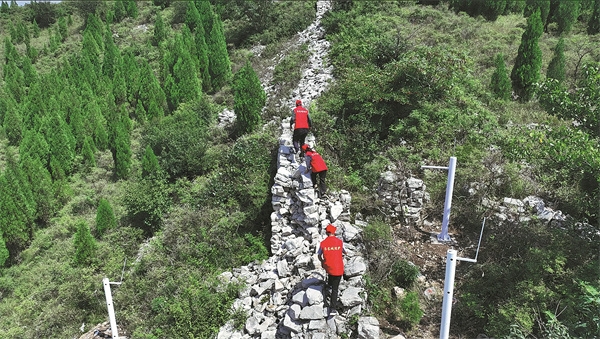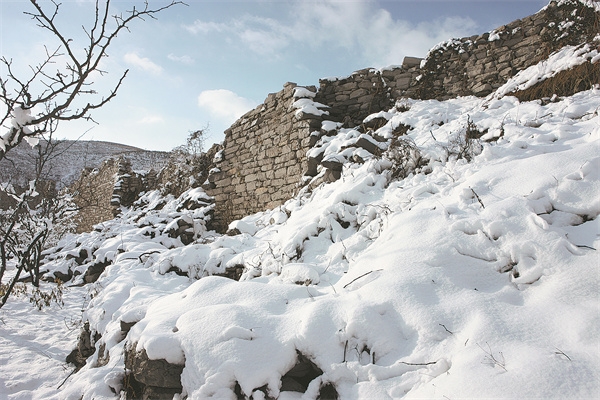Great Wall of ancient Qi state gets improved protection

Patrollers check a section of the Great Wall of the ancient Qi state in Zibo, Shandong province.[Photo provided by Hu Deding/For China Daily]
To tackle challenges in protecting the Great Wall of the ancient Qi state, the oldest existing Great Wall in China, the legislature in Shandong province has passed a regulation protecting the structure that will take effect on Jan 1.
The Qi state wall stretches across Shandong for 641 kilometers, from the province's capital Jinan on the banks of the Yellow River to the coastal city of Qingdao in the east. It was built during the Spring and Autumn Period (770-476 BC) and the Warring States Period (475-221 BC).
A section of the wall is in Guangli village, Xiaoli town, just a one-hour drive from downtown Jinan.
Located among an expanse of fields, the rammed earth wall stands three meters tall and spans 260 meters.
"Historical records say the Qi state built the wall here to defend itself from its enemies, as well as to stop flooding," says An Xingzhu, who worked at the town's culture station for more than three decades. A key task of the station is to protect cultural relics.
"I have known this wall since I was a child and we used to call it a 'range'," he says.
In the 1970s, parts of the rammed earth wall were dug out and used by farmers for their land, but since the early 1990s, the local government has started to take measures to protect the wall, says An.
Rapid development and construction have brought many new problems and challenges in protecting the Qi wall, according to Qi Yan'an, an official with the provincial justice department, who addressed a news conference last month.
"It is necessary to provide a solid legal guarantee for its conservation," he says.
The new regulation specifies the responsibilities of various departments — reform and development, education, public security, human resources, natural resources, environmental protection, urban and rural construction, water conservation, transportation and emergency management.
A snow-covered section of the Great Wall in Jinan, Shandong.[Photo provided by Hu Deding/For China Daily]
It also emphasizes regional cooperation in the protection and utilization of the Qi wall.
It states that local governments will establish a dynamic conservation system using remote sensing satellites, drones, information platforms and other technological means to monitor the Great Wall, its related infrastructure and the surrounding environment.
Tourism services featuring the Qi wall will be further standardized to balance protection and development, says the regulation.
It states that protection organizations need to carry out daily patrols and checks, as well as conduct maintenance and repairs.
This year, Shandong has added 860 patrol posts in seven cities along the Qi wall, mainly recruiting farmers living nearby.
Guo Jialian has been patrolling the section of the wall in Guangli village for three months.
The 59-year-old spends around two hours every day walking along a section of the Qi wall.
"I need to check whether there is any damage to the wall that is caused by people digging earth from it and if there is any construction nearby," says Guo.
"Awareness of protecting the Qi wall has been enhanced in recent years. We all know the wall is a cultural relic," says Guo, adding that he frequently sees tourists coming to visit the ancient structure.





